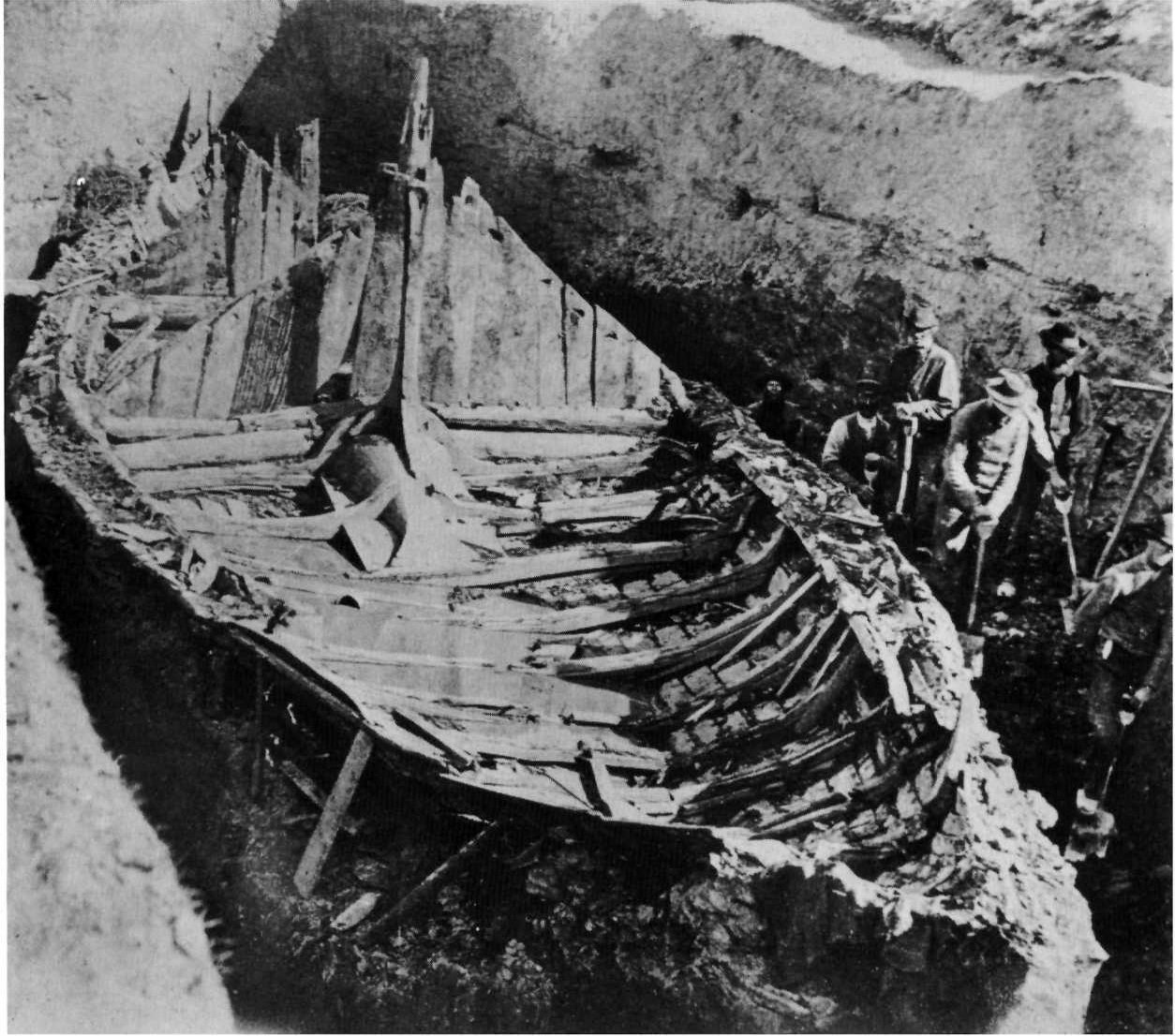Viking Longships: Fearless Dragonships Daring The Oceans And Seas
Ellen Lloyd - AncientPages.com - The Vikings were the lords of the oceans. One of the main reasons behind the Vikings' success in reaching distant lands lies in their remarkable longships. The Vikings’ ships were the European Dark Ages' greatest technical and artistic achievement. Without these great ships, the Viking Age would never have happened.
Viking warrior with a sword standing near Drakkar on the seashore. Credit: Adobe Stock - Nejron Photo
During the Viking era, there were different classes of ships. The longships were mainly used as warships, and the ships called Knarrs (or knorrs in Old Norse) served as slower passenger and cargo ships.
Viking longships were fast and could sail in shallow water. This gave the Vikings the possibility to travel up rivers as well as across the sea. In a raid, a ship could be hauled up on a beach. To surprise your enemy was an important strategic military tactic that gave the Vikings several advantages. The Vikings could jump out, start fighting, and then quickly get away if they were chased.
Many Viking ships were equipped with a dragon head on the bow. The dragon was one of the most famous symbols of the Vikings. Vikings believed the dragon could protect them against evil spirits at sea.
Vikings built their ships beside a river or an inlet of the sea. A tall oak tree was cut to make the keel. The hull of the ships was made of overlapping planks and secured with iron rivets. This made the ships very strong. A wool string was dipped in tar and forced between the planks to prevent leaks.
One man worked a big steering oar at the back end, or stern, to steer the ship.
A Viking ship with a dragon head. Credit: Adobe Stock - mastclick
Dragonships were large longships with carved heads of dragons and other magical beings mounted on their stem. They were ships for chieftains and kings. The ship’s dragonhead was a visual message about the owner’s status.
His dragon with her sails of blue,
All bright and brilliant to the view,
High hoisted on the yard arms wide,
Carries great Canute o’er the tide.
Brave is the royal progress — fast
The proud ship’s keel obeys the mast,
Dashes through foam, and gains the land,
Raising a surge on Limfjord’s strand. (The Song of Canute, Saga of St. Olaf)
"The dragonhead should scare away enemies. It also had magical functions: It would provide protection for ships and crew – and it should ward off evil spirits both on land and sea. The Icelandic law code Grágás says that the dragonhead should be taken off the ship when the Vikings returned to their homestead, not to intimidate the spirits of their native land. (Grágás was used from about 930 and written down about 1117)
The dragonhead made it easy to recognize a certain ship. It clearly shows who the leader is and where the leader is in battle. The symbolic function of the dragonhead is enhanced by the fact that ships often were named after the magical animal that graced its prow."1
A dragon ship was usually between 30-50 meters long and could carry 40 and 60 oarsmen. The men slept and ate on the deck. There was some space below the deck for stores but no cabins. Two of the most famous Viking Ships, the Gokstad Viking ship, and the Oseberg ship, were found by archaeologists in Norway.
Both ships were buried in Viking funerals between AD 800 and 900 and are now in the Viking Ship Museum in Oslo, Norway.
It was in a longship that Leif Eriksson landed on the American coast around the year 1000, long before Columbus. Of course, all other famous Viking warriors used longships when they traveled to other countries.
The longships were more or less invincible and gave the Vikings a vital advantage when they went to war or raids.
Updated on January 17, 2024
Written by – Ellen Lloyd - AncientPages.com
Copyright © AncientPages.com All rights reserved. This material may not be published, broadcast, rewritten or redistributed in whole or part without the express written permission of AncientPages.com
Expand for referencesMore From Ancient Pages
-
 Puzzling Huge Ancient Sayhuite Monolith In Peru Remains An Unsolved Mystery
Civilizations | Jul 23, 2016
Puzzling Huge Ancient Sayhuite Monolith In Peru Remains An Unsolved Mystery
Civilizations | Jul 23, 2016 -
 Ancient Roman Portable Toilets Studied By Scientists
Archaeology | Feb 11, 2022
Ancient Roman Portable Toilets Studied By Scientists
Archaeology | Feb 11, 2022 -
 Siberian Shigir Idol With Seven Faces Is The World’s Oldest Wooden Sculpture
Archaeology | Sep 1, 2015
Siberian Shigir Idol With Seven Faces Is The World’s Oldest Wooden Sculpture
Archaeology | Sep 1, 2015 -
 Study Reveals Average Age That Women And Men Had Children Over Past 250,000 Years
DNA | Jan 10, 2023
Study Reveals Average Age That Women And Men Had Children Over Past 250,000 Years
DNA | Jan 10, 2023 -
 On This Day In History: First Battle Of Gaza Was Fought – On March 26, 1917
News | Mar 26, 2017
On This Day In History: First Battle Of Gaza Was Fought – On March 26, 1917
News | Mar 26, 2017 -
 Rare Collection Of Roman Coins Unearthed In Ancient City Of Aizanoi, Turkey
News | Feb 4, 2021
Rare Collection Of Roman Coins Unearthed In Ancient City Of Aizanoi, Turkey
News | Feb 4, 2021 -
 Babylonian Astronomers Used Geometry To Track Jupiter – 1,400 Years Before Europeans
Archaeology | Jan 28, 2016
Babylonian Astronomers Used Geometry To Track Jupiter – 1,400 Years Before Europeans
Archaeology | Jan 28, 2016 -
 17 Mysterious Miniature Coffins In Scotland Remain An Unsolved Enigma
Artifacts | Feb 24, 2018
17 Mysterious Miniature Coffins In Scotland Remain An Unsolved Enigma
Artifacts | Feb 24, 2018 -
 Mystery Of The Yaghan People: The First True Discoverers Of America?
Civilizations | Sep 19, 2016
Mystery Of The Yaghan People: The First True Discoverers Of America?
Civilizations | Sep 19, 2016 -
 Researchers Find An Elusive European Ancestor Of Lager Yeast In Ireland
Archaeology | Dec 14, 2022
Researchers Find An Elusive European Ancestor Of Lager Yeast In Ireland
Archaeology | Dec 14, 2022 -
 Ancient Underground Tombs And Lightening God In Peru – Complex Concepts Of Death And Renewal Revealed
Archaeology | May 22, 2018
Ancient Underground Tombs And Lightening God In Peru – Complex Concepts Of Death And Renewal Revealed
Archaeology | May 22, 2018 -
 Part Of Jerusalem’s Wall Destroyed By The Babylonians In 586 BC – Unearthed
Archaeology | Jul 30, 2021
Part Of Jerusalem’s Wall Destroyed By The Babylonians In 586 BC – Unearthed
Archaeology | Jul 30, 2021 -
 Adaptable And Flexible Neanderthals May Have Inhabited Danish Island 120,000 Years Ago
Archaeology | Oct 25, 2020
Adaptable And Flexible Neanderthals May Have Inhabited Danish Island 120,000 Years Ago
Archaeology | Oct 25, 2020 -
 Anasazi: Sophisticated Civilization That Disappeared Or Evolved Into American Indians Of Southwest
Civilizations | Dec 3, 2016
Anasazi: Sophisticated Civilization That Disappeared Or Evolved Into American Indians Of Southwest
Civilizations | Dec 3, 2016 -
 The Ruins Of Pennard Castle And The Tale Of Faeries’ Curse
Featured Stories | Mar 2, 2016
The Ruins Of Pennard Castle And The Tale Of Faeries’ Curse
Featured Stories | Mar 2, 2016 -
 Rare Ancient Underwater Maya Ruins And Salt Kitchens Discovered
Archaeology | Oct 13, 2022
Rare Ancient Underwater Maya Ruins And Salt Kitchens Discovered
Archaeology | Oct 13, 2022 -
 Day Of The Dead: From Aztec Goddess Worship To Modern Mexican Celebration
Ancient Traditions And Customs | Oct 30, 2019
Day Of The Dead: From Aztec Goddess Worship To Modern Mexican Celebration
Ancient Traditions And Customs | Oct 30, 2019 -
 Hammurabi: The Great King Of Babylon And His Laws
Civilizations | Oct 21, 2016
Hammurabi: The Great King Of Babylon And His Laws
Civilizations | Oct 21, 2016 -
 Traces Of An Unknown Ancient Race Of Winged Beings And Other Mysterious Creatures Discovered In Japan
Ancient Mysteries | Nov 30, 2018
Traces Of An Unknown Ancient Race Of Winged Beings And Other Mysterious Creatures Discovered In Japan
Ancient Mysteries | Nov 30, 2018 -
 Unique Statue Of Warrior Wearing A Phrygian Cap Accidently Discovered By Dutch Fishermen
Archaeology | Aug 2, 2022
Unique Statue Of Warrior Wearing A Phrygian Cap Accidently Discovered By Dutch Fishermen
Archaeology | Aug 2, 2022



